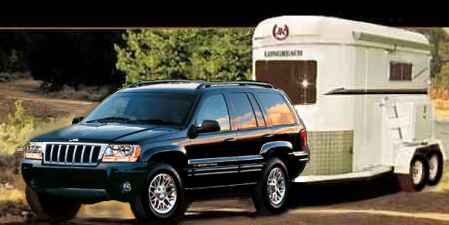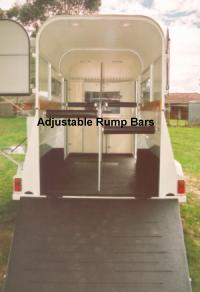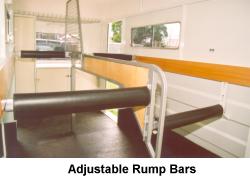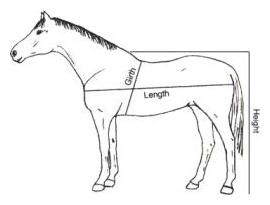|
|
|
|
|
|||||
 |
||||||||
 |
THE HORSE | |||||||
| COMMON
(HORSE) SENSE When floating horses, common sense will go a long way towards avoiding problems. Being prepared, just in case of the unforeseen circumstances, will also help. Before you set off with an unfamiliar horse be sure of what you can expect - for instance, do not plan for your first float trip with a new or young inexperienced horse to be very far. Make this first trip (or first few trips) a short distance, to enable you to understand how your horse travels, and if you need to take any special precautions. A hint when buying a horse is to ask the owner to load the horse for you and take particular notice for signs of previous scrambling such as scrape marks on the walls, as this may indicate that the horse is not a confident traveller. JR Easy Traveller design is known to make a significant difference in stopping horses from scrambling and helping to prevent young horses from learning to scramble.
Prior to loading the horse and leaving home, be sure to thoroughly check your horse/s to ensure that there is no obvious problems such as lameness, swellings in any legs or elsewhere, eye or nose discharge etc. Taking the horse’s temperature before you go will ensure that he is up to the trip and whatever activity you have in store for him at the other end. A raised temperature usually indicates that an infection is present and you may wish to investigate this before you leave. If a rise in temperature is identified when you arrive at your destination, you can suspect travel sickness and act accordingly. Be sure to read the chapter on Travel Sickness thoroughly, so that you understand the symptoms and preventative measures (make sure you take a thermometer). A well ventilated float is a must particularly in warm weather, and in such conditions make sure that you open the vents and/or windows to ensure the best possible ventilation. Be very sure that your float and its ramp have a good anti-slip floor. Some floors get very slippery if the horse passes manure on it - which almost always happens when they become slightly nervous - like when you ask the horse to go on the float. Some horses travel much better if you lay straw on the floor. JR Floats have a completely sealed floor and the wider base design allows for a scupper or drain hole at the rear on each side to allow urine and water to drain, which in turn keeps the floor dry and prevents the floor boards from rotting. Train your horse properly before you set off on your first journey. Firstly, train him to walk onto the float without hesitation (see the chapter on Floating, by Andrew McLean). It is very important that your horse will walk on and then stand while the breeching door/gate is secured. This training can take quite some time, and if not done thoroughly the horse can easily let you down when it comes to loading, when you least need a problem. Horses that are not properly trained can also put you and other at risk by running out of the float or around in order to avoid going on to the float. Read Andrew McLean's advise about Loading a Horse, and how to train your horse to load on a float, he offers some very good advise. Do not set out to teach the horse to load on the day that you have to be at a competition in an hours time! Even if you are lucky enough to get him on, he may panic shortly after you leave the safety of your property, and you will find yourself in a very worrying and dangerous predicament. Under no circumstances allow yourself to be talked into blindfolding your horse, not should the use of the whip become anything stronger than a tap. Horses never forget being frightened or harassed, and you may cause long standing problems that will be very difficult to overcome. Read Andrew McLean's chapter on Floating - Initial training and re-training, if that does not work for you e-mail Andrew on eqbehsol@ontherun.com.au Part of his training should include making him accustomed with wearing floating boots or bandages. These items of ‘horse clothing’ are usually thick and cumbersome, and if the horse is not used to wearing can cause the floating problems that they are designed to minimise. Some horses will travel better without boots, as they can cause some fractious individuals to kick at the boots themselves. Ordinary work boots such as shin and tendon boots may be helpful in such cases, and whilst they offer less protection, most horses wear them as a part of their daily routine and will accept them better. If you have two horses on the float, bell boots will protect their coronets and hoofs in the event that one or the other loses balance and accidentally steps on the other horse. If you only have one set of bell boots, put them on the two legs of each horse that is alongside the other (inside pairs of legs for both horses) for best effect. To protect the horse’s tail from rubbing during the journey, you may wish to purchase a tail guard - either the leather buckle up version which attaches to a D on the rug, or the simple ones which attach with velcro. Be extremely careful if you bandage the horse’s tail, as the bandage will need to be firm enough to stay in place, but just a little tight will run the risk of cutting off the circulation, causing problems which may lead to the possibility of amputation of the horse's dock and tail. This sounds far fetched, but it has actually happened. Remember to take the bandage/tail guard off when you get home, it is easily forgotten when hidden under a tail flap, particularly when it is dark and you are tired! JR Easy Traveller horse floats have incorporated a design which keeps the horse’s rear end out of the way of the ramp. The rump bars are set forward of the ramp and are made to adjust to the correct height for the horse to ‘lean’ on (at about the level of the end of his dock/tail bone), therefore providing much more stability and confidence, than would be possible with regular breeching doors or chains which are usually used to secure horses into floats, and are placed at the same level as the ramp, which can cause the tail to be badly rubbed.
Make sure that you consider the weather forecast which will include the temperature when you leave home, the time for the journey and expected temperature on arrival, when you are rugging your horse for travelling (and packing spare rugs in the float). He will need less clothing than the same weather conditions in his paddock, as in the confined area of the float he will easily overheat, and become very uncomfortable. Thick float boots also contribute to the retention of body heat . Do not ‘overdress’ your horse on a floating trip. Unless it is particularly cold, they need only a very light rug. Many horses are nervous or stressed in the float, and will ‘sweat up’. It is better to travel a horse without a rug than to risk discomfort and overheating (not to mention the need to wash you horse at the other end, when presentation is of importance!). If you horse starts to become restless during a trip, check that he has not become too hot. Your saddlery store will, most likely have a great range of rugs using modern fabrics that do not overheat the horse, but prevent him from catching a chill. On very hot days, you should open the top ventilators and side windows to allow for a constant breeze. Leave them closed in cooler weather, however as a very cold draught can cause stiffness and health problems. Your event performance will not be up to expectations if your horse is subjected to a draught whilst travelling.
HOW TO TIE YOUR HORSE TO MINIMISE THE RISK OF TRAVEL SICKNESS Tie the horse securely with a quick release knot. Give him enough rope to allow him to lower his head. Veterinary research has shown that if horses are prevented from lowering their head, there is a significantly increased risk of travel sickness. This head lowering action allows the horse to clear airways the way that nature intended them to, and by tying the horse high and on a short rope (as was a customary practise) you could pre-dispose him to the onset of travel stress or travel sickness. This is very serious and any doubts about the horse’s health and well-being following a float trip, should not be taken lightly. Horses can easily die from the complications of travel sickness. It is a wise practice to take their horse’s temperature the day before a big trip, before leaving and upon arrival to their destination, as an elevated temperature is one of the early signs of travel sickness. Read the chapter on Travel Sickness to ensure that you take all preventative measures and understand the early warning signs.Tie your horse so that he cannot get his head around the central head divider partition and into his travelling companion’s compartment (even if it is empty). If the horse has enough rope to allow this to happen, it will cause a frightening entanglement with the horse getting his head and neck uncomfortable jammed against a now, unmanageably tight, lead rope. You will usually hear a commotion, but if is goes undetected, your horse will be very stiff and sore for quite some days to follow, and of course will not perform well for that period of time. Always carry a very sharp knife and a spare lead rope in the vehicle with you. Should the above mentioned disaster happen, or you and your float are involved in an accident, you may not be able to untie your quick release knot, and cutting the lead rope may be your only choice. If the horse manages to turn around in the float, or goes down, do not try
to take the horse off the float by the side of the road. If you really cannot convince him
to regain his position, drive somewhere safer (and hopefully where you will have some
assistance) to take him off, preferably inside an enclosed paddock or yard. FEEDING Opinion is divided over whether horses should be given hay to munch during the journey. Hay can provide a useful distraction for an anxious horse on a long journey, but it can also be a potential source of danger if the horse breathes in particles of hay and thus chokes (you could dampen the hay net or soak the hay, as a precaution) If possible take your horse for a number of short trips so that you are
more familiar to his tolerance of feed/hay whilst travelling. GETTING ASSISTANCE If you are travelling a long distance which might involve night driving, pack a torch or battery operated spot light. You may have to inspect the horse in the float, or wave down assistance. If you have room in the vehicle or float cupboard, put in about four ‘witches hats’ so that you can divert traffic away from your float in the event of a breakdown. This can offer some peace of mind and greater safety, in an otherwise stressful situation.
FIRST AID Pack a comprehensive First Aid Kit for both the people and the horses. Think about the things that you particularly use, along with the stock standard items. A squirt of purple spray at the time of a nick can sometimes prevent a potentially nasty wound from becoming infected and needing veterinary treatment at a later stage. Deep cuts can usually be kept ‘stitchable’ if a poultice is applied immediately as this first aid treatment will assist in the control of swelling and keep the wound site clean and protected. Be sure to carry a thermometer so that you can check to see if your horse has a temperature soon after you arrive, as this is a very important first sign of travel sickness (read the chapter on Travel Sickness, so that you know all of the warning signs and preventative measures) HORSE FIRST AID KIT SHOULD CONTAIN:- WATER Many frequent travellers carry their own water to be sure that their horse will drink
and not take exception to the water at the other end of the trip. Another way to avoid
this potentially dangerous risk, is to accustom your horse to a tasty additive like
molasses, ‘Stockgain’ or apple cider vinegar which over-rides the often
distinctive taste of the local water supply. You can then ‘give him a treat’,
and he will drink the local water without hesitation. This pre-travel ‘training’
is well worthwhile in order to allow your horse to perform to his best when away from
home. JR Easy Traveller can supply a stainless steel water tank which fits neatly onto the
rounded section at the front of the float. The tank holds approximately 70 litres of
water. See SPARE HEAD STALL (HALTER) AND LEAD ROPE Nothing is worse than getting to your destination and having your horse take fright and
break his head stall or lead rope, or perhaps you had not noticed the first signs of wear
and tear. It does not take much to put a spare in the float, and it is surprising how
often you have a use for the spare! CHECK OUT THE SPECIALST EQUIPMENT BEFORE YOUR TRIP You may have everything that you will be needing to float your horse in comfort and safety but a trip to you local saddlery store to ask their advise, may give you a few little hints that are well worth knowing. They usually have a good selection of the horse equipment that you may need, and the items that go to make up your horse first aid kit. These things should be kept separate from your day to day gear, so that you know your ‘floating kit’ is complete and ready to go.
As part of planning a float trip, you may need to know how much your horse weighs. This can be calculated in the following way: Measure him around the girth in centimeters . Girth in cm, squared x length in cm, divided by 8717 = weight in Kilograms.
|
||||||||



 YOUR HORSE’S WEIGHT
YOUR HORSE’S WEIGHT